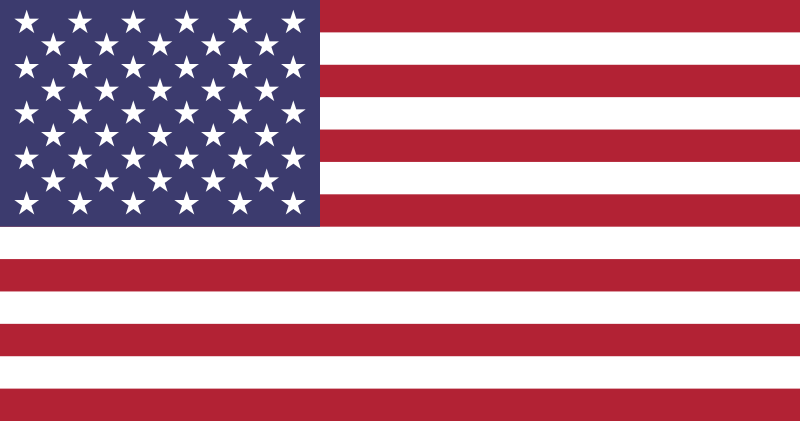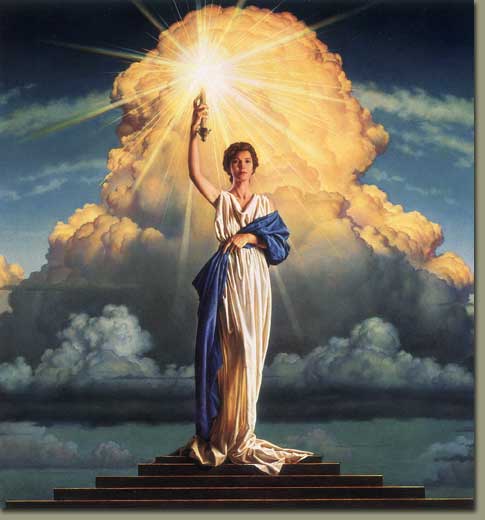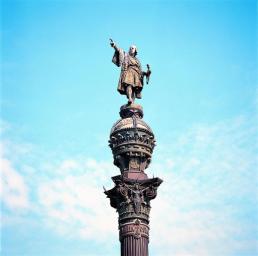

The North American elections have made me think about a “virtual” visit to the States and see parallelisms between this and our nation, that some time ago was, like the Americans, a great world power and which, in Servent’s words “was in front of the Nations of the world”.
The Catalan origins of the flag of the USA

The formation of the flag of the United States of America would part from an evolution of the Catalan flag that the English took as a model for the British East Indian Company. Besides its design with red and white stripes, without precedents in England, curiously, the evolution of the number of stripes or paly coincides too ,as in the Catalan ensign, with the number of territories that would represent. From the five original territories (England, Scotland, Wales, Ireland and the American Colonies), as well as the different American patriots revolutionary flags that represented the number of colonies until the flag of the thirteen stripes (seven red and six white) of the thirteen foundational colonies that became independent from the British Crown. Though the number of stripes will remain unchanged from then, and they are the actual number, the increase in the number of States of the Union would be represented by the number of stars within the flag. Because of the red colour used, design of the stripes and their territorial meaning, the Catalan influence in the historical and iconographical reference appears evident in the origins of the formation of this flag.

Evolution from the Catalan ensign to the actual flag of the United States of America
But the presence of the Catalan stripes is not an exclusive fact of the National flag, other North American States and Puerto Rico reflect an original Catalan presence that has been usurped, tergiversated and converted in Castilian under the ambiguity of the name “Spanish”.


From the left, the flags of New Mexico and Arizona

Coat of arms of San German de Puerto Rico
The proliferation of Catalan ensigns because of the Catalan presence throughout the world, the ignorance and the oblivion about our nation is so great that there are anecdotes like this one, where a Catalan saw a Catalan flag hoisted by the entrance of a Museum in honour of the USS Constitution, in Boston, and the person who had ordered it, because they had seen it in a paint of the Battle of Tripoli, who had hoisted it every day, could give this man no explanation where that flag had come from. The visitor went away intrigued to know if our ancestors had to do anything with the first international naval battle of the United States of America. If you pay a little attention, is not difficult to find Catalan references in the American films and series.
Catalan contribution in the formation of a new nation
Precisely a sea man, Jordi Ferragut Mesquida, born in Ciutadella de Menorca during the British occupation of the island, who took nautical studies in Barcelona, left Catalonia and emigrated to the United States, where he worked in the Merchant Navy and fought the British in the American Independence War. In the Battle of Cowpens, it was highlighted that he saved the life of somebody called George Washington, one of the fathers of the Nation and who would become the first President of the United States. Jordi’s son, Jaume Ferragut, would be adopted by the future Captain of the Navy David Porter, who changed his name to David Farragut, would become the first major officer of the Navy during the Civil War and was the first counter-admiral, first vice-admiral and first admiral of the US Navy. The name of Farragut is today one of the symbols of America i bear his name several military academies, schools, towns, squares and streets, monuments and appears in diverse manifestations of popular culture, as the fleet of spaceships Farragut in the Star Trek series, or the Commodore Farragut in the novel “20000 leagues under the sea” by Jules Verne. Minorcan’s immigration to Florida within that time was not punctual, even today, their descendents surprise and thrill us seeing that they keep some of the customs, preserving Catalan vocabulary and now, thanks to internet, the blog The Minorcan Factor or Minorcanculture, among some of them.

But Catalan presence in North America did not begin in the 18th Century with Minorcan immigrants or figures like Gaspar de Portolà and Fra Juníper Serra, it is shown evident from the beginning of the Catalan landing in the continent at the end of the 15th Century, with Colom and other Catalans like Joan and Sebastià Cabot in Terra Nova.
The very name of Florida would be a Catalan name too, given by Joan Pons d’Agramunt –later converted by the censorship in a Castilian called Juan Ponce de León. Intuitively, it is perceived the Catalan origin of names like California, Pensacola –from our Peniscola-, and so many others.

Catalan place names in the United States: Barcelona Harbour, València, Farragut, Juniper Serra Mountain, Montserrat, Cabot, Porter, Coloma, Montfort, Pineda, Ponset, etc...
The name of the Nation and the political structure
Like the old Catalonia, the United States of America are formed, like everybody knows and like their own name indicates, by a series of States with their own laws. The North American federal culture is expressed by a national coat of arms with the legend “Pluribus unum”, the unity in plurality. It is common too, the county as a local or regional government form, as well as it was in the Principality of Catalonia. Equally, besides the States, the Federal District, which lays besides of the dependence of any other State member. It is known as Washington DC because of the name of the city that constitutes the district, the official name of this singular territory that exercises as capital of the Nation is District of Columbia, hence the initials DC.


Like in Catalonia, too, the Americans have had their discrepancies with regards to the name of the Nation. Precisely, the denomination of the capital district answers to the remaining of what, at the time, was proposed as the name of the whole Country: Columbia. Explained in the Wikipedia, Columbia was the first popular and poetic name of the United States of America and is a grammatical feminine form derived from the name Cristofor Colom. The denomination dates from before the Independence War in 1776, but was forgotten in the 20th Century. The Americans appealed to the figure of Colom instead of the figure of the Cabot brothers, promoted by the English.
George R. Stewart says that the name “United States” was criticised for too long, imprecise and slightly poetic, and said that the Constitutional Convention in 1787 would have been the perfect moment to change it. The two characters who probably had argued more for a better name, following Stewart, would be Thomas Jefferson and Benjamin Franklin. However, the Nation kept the name of “United States” although the popular support for “Columbia” remained. Finally, the establishment of a new independent country with the name of Colombia had provoked that the denomination “Columbia” was not longer available for the United States, therefore their progressive abandonment. In spite of that, the name “Columbia” appears constantly in North America and even remains as the personalization of the Nation in feminine figure, equivalent to the masculine “uncle Sam”, normally associated to the President.


Columbia, the feminine representation of the United States of America, derived from Colom, is today symbol of Columbia Pictures. The United States and Catalonia in today’s world.


The United States have always looked out for our country in the moments where new independent States have been born in the old Europe. The return of Catalonia to the international political arena is seen with good eyes by America, which need to have strategic associates in the western Mediterranean, with European States dedicating their efforts to improve their economies, and not managing internal territorial problems. But from Catalonia, we have not understood nor correspond adequately the possibilities that the international chequer offers to us.
Yet with President Wilson, the regionalist Catalan politicians at the beginning of the 20th Century missed asking him for support for having an Autonomy, that he declined for being and “internal affair” with the Spanish State, instead of asking directly for independence, in a moment where the independences of Poland, Czechoslovakia, Hungary or Ireland were facilitated. During the 2nd World War, too, existed a project to make, at least the Principality, an independent State to facilitate the Allied offensive against Fascism in Europe, that finally was not approved. More recently, President Clinton affirmed that “future will be either Catalan or Taliban. In a Catalan world, we would celebrate the differences, because they are a manifestation of the common Humanity. In a Taliban world, the differences are the only thing that matters”.
Events like September 11th 2001, unite one more time America with our own September 11th 1714 and increases the long list of shared symbols, even though Spain has tried to hide and usurp them. Now, the United States are to begin a new era with a new President, it is interesting to see how the American Democrats have adapted the Catalan donkey as the sign of their party. Democrats Abroad have bought copyright to the proprietor of said donkey to use it as the official sign in the campaign of Barack Obama to the American Democrats overseas. And from the Republican benches, Robert Kagan, John McCain’s assessor in international politics, referred to the supporters for independence of Catalonia and other European countries in a press article. Nobody was surprised that with the actual American President, we have another opportunity to see an independent Catalonia among the other European nations. But to do so, Catalans must have especially present this paragraph of the Declaration of Independence of the United States: “But when a long train of abuses and usurpations, pursuing invariably the same Object evinces a design to reduce them under absolute Despotism, it is their right, it is their duty, to throw off such Government, and to provide new Guards for their future security”.
Published at “Es Poblat d’en Talaiotic”

i love America and im now in a processing to a citizen of United States
ReplyDeleteHungarian flag in X century: http://upload.wikimedia.org/wikipedia/hu/thumb/e/e8/Az_%C3%81rp%C3%A1d-h%C3%A1zi_kir%C3%A1lyok_csal%C3%A1di_z%C3%A1szlaja.jpg/200px-Az_%C3%81rp%C3%A1d-h%C3%A1zi_kir%C3%A1lyok_csal%C3%A1di_z%C3%A1szlaja.jpg :)
ReplyDeleteMadre mía, pero esta película de donde sale? Menudas patadas a la historia ... solo os falta hacer las SS Catalanas para ir a la marcha de la sombra del NAZISMO
ReplyDelete